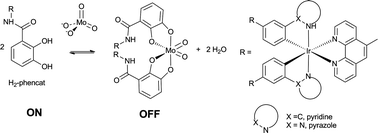Luminescent iridium complexes for detection of molybdate†
Abstract
Reactions of [Ir(C⁁N)2Cl]2 [HC⁁N = 2-(3-R-phenyl)pyridine, 2-(3-R-phenylpyrazole) R = H, Me] with Me2-phencat give luminescent complexes [Ir(C⁁N)2(Me2-phencat)][PF6] (Me2-2a, b, c)[PF6]. Deprotection of the methoxy groups with BBr3 is problematic as simultaneous


 Please wait while we load your content...
Please wait while we load your content...